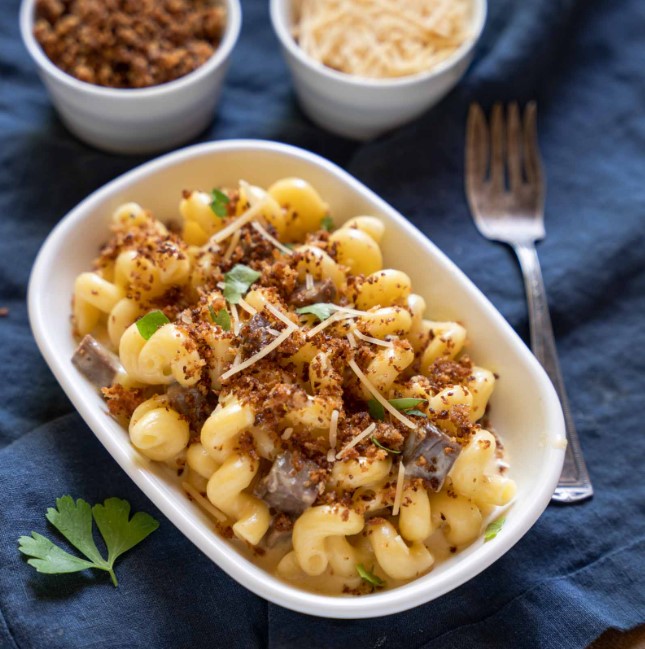History and Origin of Brisket Mac and Cheese
The history of Brisket Mac and Cheese is a tale of two distinct culinary paths converging. Macaroni and cheese has its roots in European cuisine, with recipes dating back to the 14th century. It became a beloved dish in America after being introduced, reportedly by Thomas Jefferson, in the late 18th century. On the other hand, brisket, particularly smoked brisket, is deeply entrenched in the American barbecue tradition, especially in the Southern states where smoking meats was a method perfected over centuries. For a deeper understanding of barbecue techniques that likely influenced this dish, explore Expert BBQ Techniques.
The evolution of combining brisket with mac and cheese is a relatively recent phenomenon, mirroring the modern fusion cuisine trend. It symbolizes a blend of the rustic, deep flavors of smoked meat with the creamy, comforting texture of macaroni and cheese. This recipe evolution reflects a growing desire for hearty, flavor-packed comfort foods, making brisket mac and cheese a modern classic in American cuisine. For those interested in exploring other classic comfort foods, check out our Hearty Beef Stew Recipe Without Wine.
Ingredients and Variations
The classic Brisket Mac and Cheese recipe hinges on a few key ingredients. Central to the dish is the brisket, ideally slow-cooked and smoked to achieve a tender, flavorful profile. The macaroni, typically elbow-shaped, serves as the base for the cheese sauce, a rich blend often made from a roux of butter and flour, milk, and a variety of cheeses. Common cheese choices include sharp cheddar for its strong flavor, smoked gouda for a hint of smokiness, and gruyere for a smooth, creamy texture. For guidance on cheese selection, visit Choosing the Right Cheese for Mac and Cheese.
Variations of this dish are abundant, reflecting regional tastes and culinary creativity. In Texas, for instance, a spicier version might include jalapeños or a barbecue sauce mixed into the cheese sauce. Some cooks in the Midwest prefer to add a crunchy topping, like breadcrumbs or even crispy onions, for an added textural contrast.
Other variations play with the cheese blend, incorporating local or artisanal cheeses. In more health-conscious adaptations, whole wheat pasta, low-fat cheeses, and leaner cuts of brisket are used. Vegetarian versions substitute the brisket with smoky-flavored vegetables like roasted mushrooms or smoked tofu, ensuring the dish’s signature flavor profile remains intact. Each variation of brisket mac and cheese offers a unique taste experience, celebrating the dish’s versatility and widespread appeal. For those who love the combination of cheese and pasta, our Pasta Fettuccine Carbonara recipe is a must-try.
Cooking Techniques
Mastering Brisket Mac and Cheese involves perfecting two key components: smoking the brisket and preparing the mac and cheese.
Smoking Brisket: The process begins with selecting a high-quality cut of brisket. Seasoning is crucial; a rub typically made from salt, pepper, garlic powder, and other spices is generously applied. The brisket is then smoked at a low temperature for several hours, allowing the meat to absorb the smoky flavors and become tender. Maintaining a consistent temperature and using quality wood chips, like hickory or oak, are essential for achieving the perfect smoke.
Preparing Mac and Cheese: This starts with cooking the pasta, usually elbow macaroni, to al dente. The cheese sauce, starting with a roux of butter and flour, forms the heart of the dish, with milk added to it. As the mixture thickens, melting a blend of cheeses into the sauce creates a rich, creamy texture. For extra flavor, you can add seasonings like mustard powder, salt, and pepper.
Combining the Two: The final step is combining the smoked brisket, cut into bite-sized pieces, with the creamy mac and cheese. You can either combine the flavors by baking in the oven or add brisket as a hearty topping. The result is a harmonious dish where the smokiness of the brisket perfectly complements the richness of the mac and cheese.
For those interested in a gluten-free version of this classic dish, our Gluten-Free Mac and Cheese guide offers great alternatives.
Advanced Cooking Tips
Achieving the perfect Brisket Mac and Cheese requires a few expert tips, especially when it comes to preparing the brisket, selecting the right cheeses, and balancing the flavors.
Perfecting the Brisket:
- Marination: Marinate the brisket for at least a few hours, if not overnight, to enhance its flavor.
- Low and Slow: Cook the brisket at a low temperature for several hours. This slow cooking process breaks down the connective tissue, resulting in tender meat.
- Resting: Allow the brisket to rest after smoking. This lets the juices redistribute, ensuring the meat is moist and flavorful.
Cheese Selection and Sauce Preparation:
- Cheese Variety: Use a mix of cheeses for depth of flavor. A combination of sharp cheddar for tang, smoked gouda for smokiness, and a creamy cheese like gruyere or fontina works well.
- Sauce Consistency: For the cheese sauce, start with a smooth roux, then gradually add milk to avoid lumps. Add the cheese gradually and stir until melted for a smooth, creamy sauce.
Balancing Flavors:
- Contrasting Tastes: Incorporate elements like a dash of hot sauce or Dijon mustard to cut through the richness of the cheese.
- Layering Flavors: Add herbs or spices like thyme, paprika, or garlic powder to the cheese sauce for complexity.
- Texture: Consider a crunchy topping like panko breadcrumbs or crumbled bacon for a contrast to the creamy mac and cheese.
These advanced tips will help elevate your brisket mac and cheese, turning it into a gourmet dish that’s rich in flavor and texture.
Serving and Pairing Suggestions
You can serve Brisket Mac and Cheese in various settings, ranging from casual family dinners to more formal gatherings. When serving, you can present it as either a main course or a side dish. For a more elegant presentation, serve it in individual ramekins topped with a sprinkle of fresh herbs or a light dusting of smoked paprika.
In terms of pairings, this rich and hearty dish goes well with a variety of drinks and sides:
- Drinks: A full-bodied red wine, like a Cabernet Sauvignon or a Zinfandel, complements the smoky brisket. For beer lovers, a stout or a porter can stand up to the robust flavors. A crisp apple cider, either alcoholic or non-alcoholic, also makes a refreshing pairing.
- Sides: Light and fresh sides balance the dish’s richness. Consider a green salad with a vinaigrette dressing, steamed green beans, or roasted vegetables. For a heartier meal, cornbread or a crusty baguette can accompany the mac and cheese.
These serving and pairing suggestions can enhance the overall dining experience, making Brisket Mac and Cheese a memorable meal.
Nutritional Information
Brisket Mac and Cheese is a hearty dish, and its nutritional profile reflects its rich ingredients. While exact caloric content can vary based on specific recipe variations and portion sizes, a typical serving can be quite calorie-dense, primarily due to the brisket, cheese, and pasta.
On average, a serving of brisket mac and cheese can contain:
- Calories: Approximately 500-800 calories, depending on the amount of cheese and brisket used.
- Proteins: A good source of protein, primarily from the brisket and cheese, contributing to about 20-30 grams per serving.
- Fats: High in fats, with a mix of saturated and unsaturated fats, totaling around 30-50 grams. The brisket and cheese are the main contributors.
- Carbohydrates: Primarily from the pasta, a serving can have about 40-60 grams of carbohydrates.
It’s also a source of essential nutrients like calcium from the cheese and iron from the brisket. However, its high caloric and fat content makes it best enjoyed in moderation, especially for those who are monitoring their calorie intake. For those watching their diet, consider pairing it with our Air Fryer Sweet Potato Cubes for a healthier side option, also For a detailed breakdown of its nutritional content, check out Nutritional Content of Brisket Mac and Cheese.
FAQs
Q: Can I make brisket mac and cheese ahead of time? A: Yes, you can prepare brisket mac and cheese in advance. Assemble the dish, cover it, and refrigerate. When ready to serve, bake it in the oven. However, the pasta may absorb some of the sauce, so it’s a good idea to reserve a bit of cheese sauce to add before baking.
Q: What’s the best way to reheat brisket mac and cheese? A: The oven is the best method for reheating to maintain texture. Reheat at 350°F until it’s hot throughout. If it seems dry, add a splash of milk or cream before heating.
Q: Can brisket mac and cheese be frozen? A: Yes, it can be frozen. Cool the dish completely, then cover it tightly with foil or transfer it to an airtight container. It can be frozen for up to 3 months. Thaw in the refrigerator before reheating.
Conclusion
In summary, Brisket Mac and Cheese is a delightful fusion of two classic comfort foods, bringing together the smoky, tender allure of brisket with the creamy, indulgent charm of macaroni and cheese. This dish stands out for its versatility in ingredients and variations, allowing for regional adaptations and personal touches. Its perfection comes from carefully preparing the brisket and mac and cheese, each adding unique flavors and textures.
This dish invites both seasoned chefs and home cooks to explore and experiment. Each step, from choosing cheeses to smoking brisket, is a creative culinary journey.
We encourage you to try this recipe, embrace the process, and share this comforting, hearty dish with friends and family. Brisket Mac and Cheese is more than a meal; it’s a celebration of cooking and sharing.


